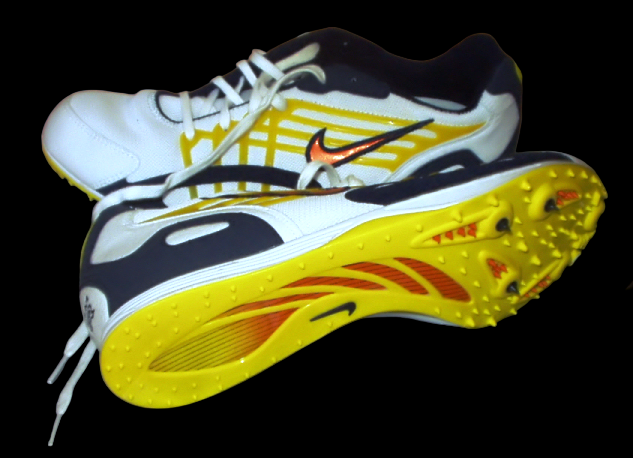Track Running Shoes
A Case Report of the Transition from Classical Spikes to “Super Spikes” in Track Running

|
OPEN ACCESS: Artigo disponível/Article available/Artículo disponible - ASSINANTE/SUBSCRIBER: Artigo para Assinante do periódico/Article for Journal Subscriber/Artículo para suscriptores de este periódico - PAY-PER-VIEW: Compre o artigo e leia/Buy the article and read/Compra el artículo y lee - IMAGE: Tênis de corrida de pista: Um relato de caso da transição dos Spikes clássicos para os “Super Spikes” na prova de pista |
Keywords:
running gait, running performance, running biomechanics, foot pressure, running shoes, spike shoes, track and field athleticsAbstract
Research on high-tech running shoes is increasing but few studies are available about the use of high-tech track spike shoes (super spikes), despite their growing popularity among running athletes. The aim of this case study was to investigate kinematics, kinetics, and plantar pressures of an Olympic running athlete using two different types of shoes, to provide an easy and replicable method to assess their influence on running biomechanics. The tested athlete performed six running trials, at the same speed, wearing a pair of normal spikes shoes (NSS) and a super spikes shoe (SSS), in random order. SSS increased contact time, vertical impact, and swing force (Effect Size 3.70, 7.86, and 1.31, respectively), while it reduced foot-strike type and vertical ground reaction force rate (Effect Size 3.62 and 7.21, respectively). Moreover, a significant change was observed in medial and lateral load, with SSS inducing a more symmetrical load distribution between the left and right feet compared to the NSS (SSS left medial load 57.1 ± 2.1%, left lateral load 42.9 ± 1.4%, right medial load 55.1 ± 2.6%, right lateral load 44.9 ± 2.6%; NSS left medial load 58.4 ± 2.6%, left lateral load 41.6 ± 2.1%, right medial load 49.2 ±3.7%, right lateral load 50.8 ± 3.7%). The results of this case study suggest the importance of using individual evaluation methods to assess shoe adaptations in running athletes, which can induce biomechanical modifications and should be considered by coaches to ensure optimal running performance.
POID
— ark:/40019/oly.v2i.19.g29
References
(1) Picerno P, Padulo J. Acute kinematic adaptations to running on a centrifugal track: A pilot study. Proceedings of the Institution of Mechanical Engineers Part P Journal of Sports Engineering and Technology. 2018 Jan 1;232(3):275–81.
(2) Ae M. The next steps for expanding and developing sport biomechanics. Sports Biomechanics. 2020 May 13;1–22.
(3) Sun X, Lam WK, Zhang X, Wang J, Fu W. Systematic Review of the Role of Footwear Constructions in Running Biomechanics: Implications for Running-Related Injury and Performance. J. Sport. Sci. Med. 2020; 19, 20–37.
(4) Nielsen A, Heyde C, Simonsen MB, Larsen RG, Hansen RK, Kersting U, et al. Reliability of Running Economy Measurements: Influence of Shoe Familiarisation. International Journal of Sports Medicine. 2022 Aug 4;
(5) Xiang L, Gu Y, Rong M, Gao Z, Yang T, Wang A, et al. Shock Acceleration and Attenuation during Running with Minimalist and Maximalist Shoes: A Time- and Frequency-Domain Analysis of Tibial Acceleration. Bioengineering. 2022 Jul 16;9(7):322.
(6) Jaén-Carrillo D, Roche-Seruendo LE, Molina-Molina A, Cardiel-Sánchez S, Cartón-Llorente A, García-Pinillos F. Influence of the Shod Condition on Running Power Output: An Analysis in Recreationally Active Endurance Runners. Sensors. 2022 Jun 26;22(13):4828.
(7) Hébert-Losier K, Pamment M. Advancements in running shoe technology and their effects on running economy and performance – a current concepts overview. Sports Biomechanics. 2022 Aug 22;22(3):1–16.
(8) Ortega JA, Healey LA, Swinnen W, Hoogkamer W. Energetics and Biomechanics of Running Footwear with Increased Longitudinal Bending Stiffness: A Narrative Review. Sports Medicine. 2021 Apr 8;51(5):873–94.
(9) Agresta C, Giacomazzi C, Harrast M, Zendler J. Running Injury Paradigms and Their Influence on Footwear Design Features and Runner Assessment Methods: A Focused Review to Advance Evidence-Based Practice for Running Medicine Clinicians. Frontiers in Sports and Active Living. 2022 Mar 9;4.
(10) Joubert DP, Jones GP. A comparison of running economy across seven highly cushioned racing shoes with carbon-fibre plates. Footwear Science. 2022 Feb 21;14(2):1–13.
(11) Healey L, Bertschy M, Kipp S, Hoogkamer W. Can We Quantify the Benefits of “Super Spikes” in Track Running?. Sports Medicine. 2022 Feb 23; 52, 1211–1218.
(12) Ardigò LP, Buglione A, Russo L, Cular D, Esposito F, Doria C, et al. Marathon shoes vs. track spikes: a crossover pilot study on metabolic demand at different speeds in experienced runners. Research in Sports Medicine. 2021 May 14;1–8.
(13) Koldenhoven RM, Hertel J. Validation of a Wearable Sensor for Measuring Running Biomechanics. Digital Biomarkers [Internet]. 2018;2(2):74–8. Available from: https://www.karger.com/Article/FullText/491645
(14) DeJong AF, Hertel J. Validation of Foot-Strike Assessment Using Wearable Sensors During Running. Journal of Athletic Training. 2020 Oct 16;55(12):1307–10.
(15) Kozinc Ž, Smajla D, Šarabon N. The reliability of wearable commercial sensors for outdoor assessment of running biomechanics: the effect of surface and running speed. Sports Biomechanics. 2022 Jan 12;1–14.
(16) Chaouachi A, Padulo J, Kasmi S, Othmen AB, Chatra M, Behm DG. Unilateral static and dynamic hamstrings stretching increases contralateral hip flexion range of motion. Clinical Physiology and Functional Imaging. 2015 May 27;37(1):23–9.
(17) Davis IS, Rice HM, Wearing SC. Why forefoot striking in minimal shoes might positively change the course of running injuries. Journal of Sport and Health Science [Internet]. 2017 Jun;6(2):154–61. Available from: https://www.sciencedirect.com/science/article/pii/S2095254617300492
(18) Jordan C, Payton CJ, Bartlett RM. Perceived comfort and pressure distribution in casual footwear. Clinical Biomechanics. 1997 Apr;12(3):S5.
(19) Witana CP, Goonetilleke RS, Au EYL, Xiong S, Lu X. Footbed shapes for enhanced footwear comfort. Ergonomics. 2009 May;52(5):617–28.
(20) Péter A, Hegyi A, Stenroth L, Finni T, Cronin NJ. EMG and force production of the flexor hallucis longus muscle in isometric plantarflexion and the push-off phase of walking. Journal of Biomechanics. 2015 Sep;48(12):3413–9.
(21) Montiel V, Valentí A, Villas C, Valverde C, Alfonso M. Hallux anatomy: much ado about shoes—an attempt to prove that constrictive V-shaped toe-box shoes deform the hallux. Archives of Orthopaedic and Trauma Surgery. 2021 Feb 16; 1–8.
________________________________
Article adapted and translated into Portuguese by the editors of OLYMPIKA MAGAZINE for republication, in accordance with the journal's submission rules. Original version at: https://www.mdpi.com/2076-3417/12/20/10195.
Published
How to Cite
Issue
Section
License
Copyright (c) 2024 Luca Russo, Eleonora Montagnani, Daniel Buttari, Luca Paolo Ardigò, Ionel Melenco, Alin Larion, Gian Mario Migliaccio, Johnny Padulo

This work is licensed under a Creative Commons Attribution 4.0 International License.






